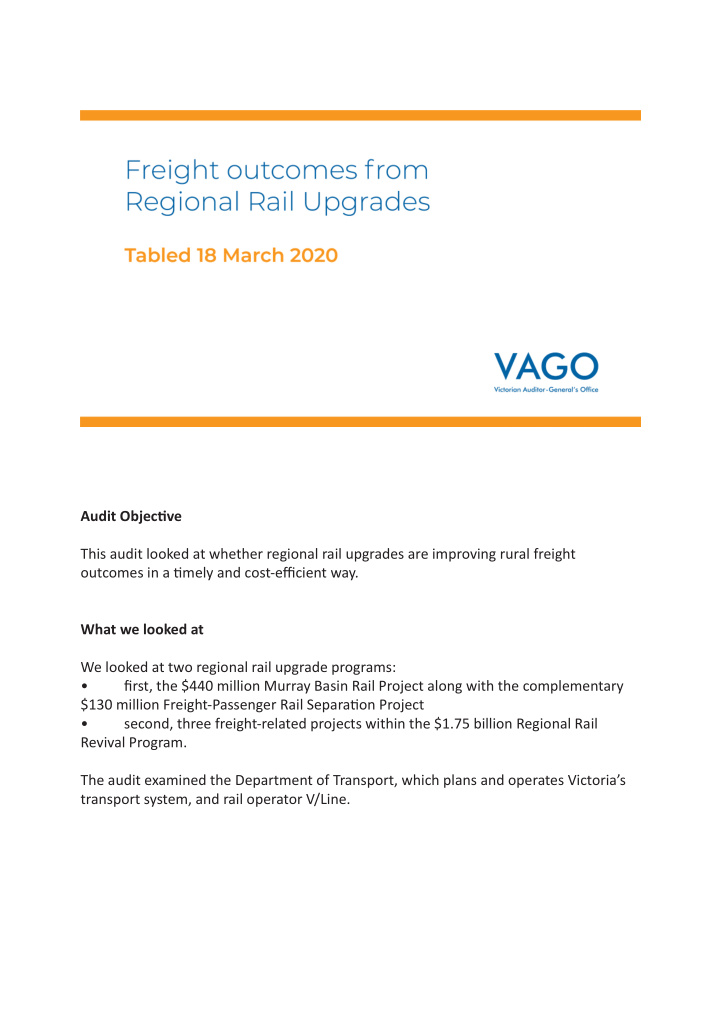



Audit Objectjve This audit looked at whether regional rail upgrades are improving rural freight outcomes in a tjmely and cost-effjcient way. What we looked at We looked at two regional rail upgrade programs: • fjrst, the $440 million Murray Basin Rail Project along with the complementary $130 million Freight-Passenger Rail Separatjon Project • second, three freight-related projects within the $1.75 billion Regional Rail Revival Program. The audit examined the Department of Transport, which plans and operates Victoria’s transport system, and rail operator V/Line.
Conclusion The regional rail upgrades we examined are not yet achieving the outcomes expected by stakeholders and government. Delivery of the Murray Basin Rail Project—including the Freight-Passenger Separatjon Project—is 15 months late and will need more funds to fully realise intended outcomes. The freight-relevant Regional Rail Revival projects require more explicit alignment to Victoria’s wider freight policy goals. Current rail freight infrastructure on these corridors is infmexible and will likely require future track adjustments. Background Victoria is a very important agriculture producer and exporter. Commoditjes have to be transported to natjonal markets or to the export ports at Geelong, Melbourne and Portland. Transport may be by road or by rail. Historically, rail freight was cheaper because rail can more easily transport greater volumes over longer distances. However, substandard rail network performance and a lack of investment have increased costs, making road more aturactjve. The 2018 Victorian Freight Plan was designed to prepare Victoria’s freight and logistjcs sector for future changes. The antjcipated benefjts of rail upgrade programs were incorporated into the plan. The Victorian government expected the Murray Basin Rail Project to deliver increases in three areas: • freight capacity • interstate competjtjon • investment by rail operators. The Department of Transport directed V/Line to deliver stage one of this project. V/Line procured and managed a contractor to deliver stages two to four. However, in June 2019, the Victorian government paused the project.
The complementary Freight-Passenger Rail Separatjon Project aimed to deliver faster and more reliable services through Ballarat. However, the Victorian government put this project on indefjnite hold in April 2019. The Regional Rail Revival Program came afuer the 2018 freight plan. It aims is to provide faster, more reliable services on every regional passenger line by 2022. This program also impacts some freight services. We examined three freight- related upgrades, on the Gippsland, Shepperton and Warrnambool lines. These works are stjll being procured so it is too early to assess performance. Issue 1: Delivery of the Murray Basin Rail Project Only 50 per cent of the original Murray Basin Rail Project’s scope has been delivered, but 86.7 per cent of the original budget has been used. This is due to: • the Department of Transport and V/Line’s defjcient project planning and inefgectjve project management • V/Line’s inadequate contract management, which has led to delays, scope changes and increased costs. Specifjc issues include: • over-optjmistjc assumptjons about works complexity • underestjmatjons of tjme and cost • a failure to report on or address risks in a tjmely manner. Issue 2: Governance of the Murray Basin Rail Project The Department of Transport and V/Line’s project governance arrangements did not support informed decision-making and were insuffjciently documented. There were gaps in accountability, and patchy or limited corporate knowledge. Further, critjcal fjndings from project reviews were not mitjgated or actjoned in a tjmely manner.
Issue 3: Inconsistent, incomplete stakeholder engagement In managing the Murray Basin Rail Project, the Department of Transport did not routjnely analyse or seek to understand stakeholder views. This included addressing requests for project appraisals from the Commonwealth, which contributed $220 million to the project. The Department of Transport’s responses were neither forthright nor tjmely. Where to from here? The Murray Basin and associated Freight-Passenger Separatjon projects will need a considerable injectjon of funds to fully realise the benefjts originally intended. However, the original Murray Basin Rail Project business case is no longer economically accurate and the Department of Transport and V/Line must also address many remaining technical challenges. Recommendatjons We have made 13 recommendatjons: • three to V/Line about resolving technical challenges and improving contract management processes • two to the Department of Transport, focusing on revision of the Murray Basin Rail Project business case • and eight combined recommendatjons for both agencies. For further informatjon, please see the full report on our website: www.audit.vic.gov.au
Recommend
More recommend